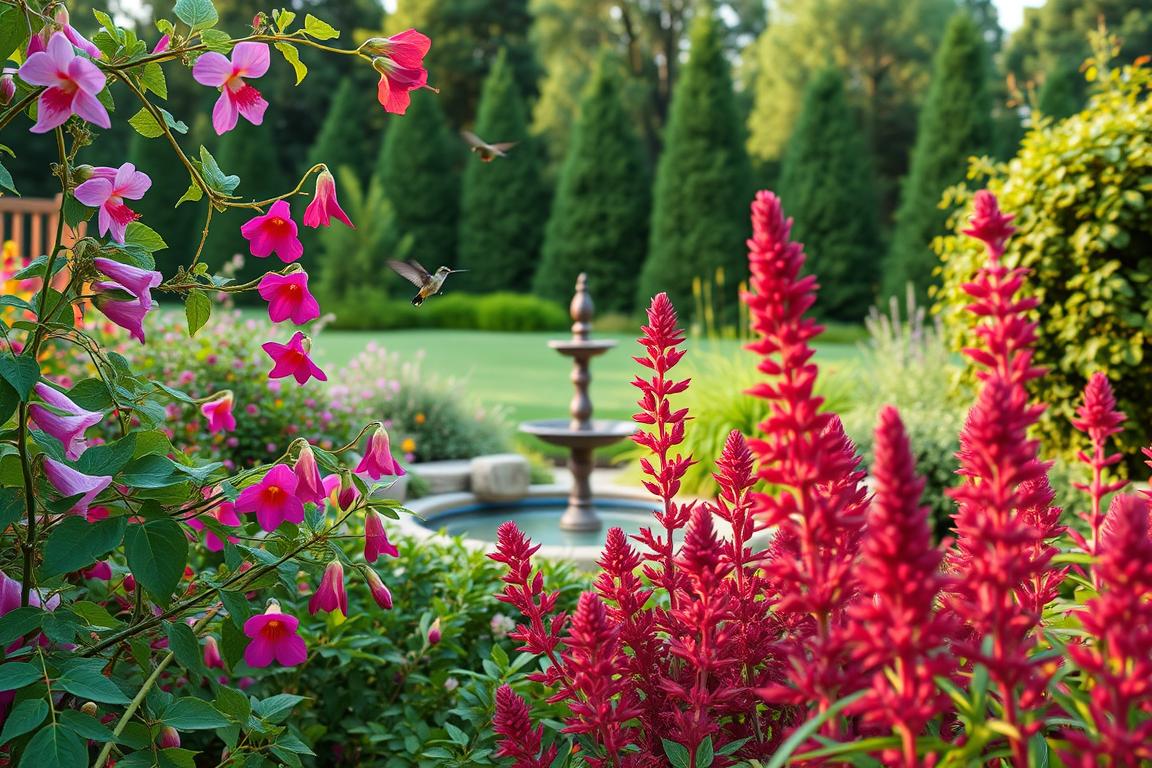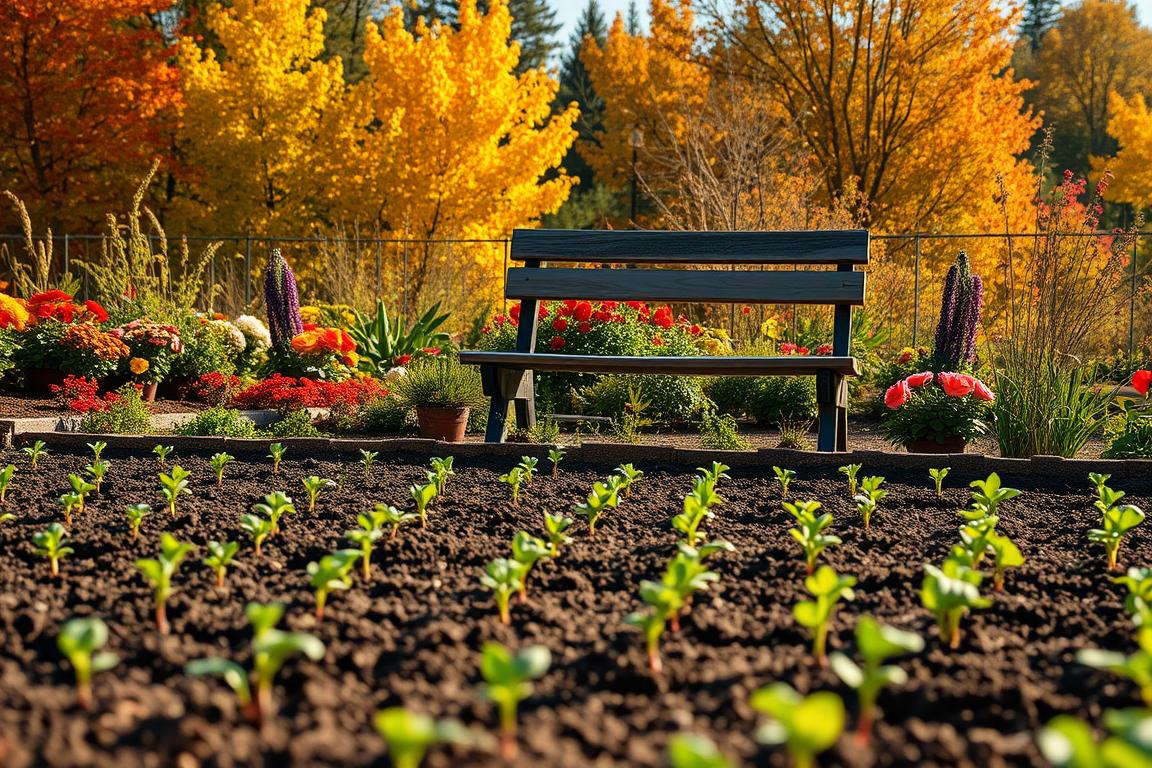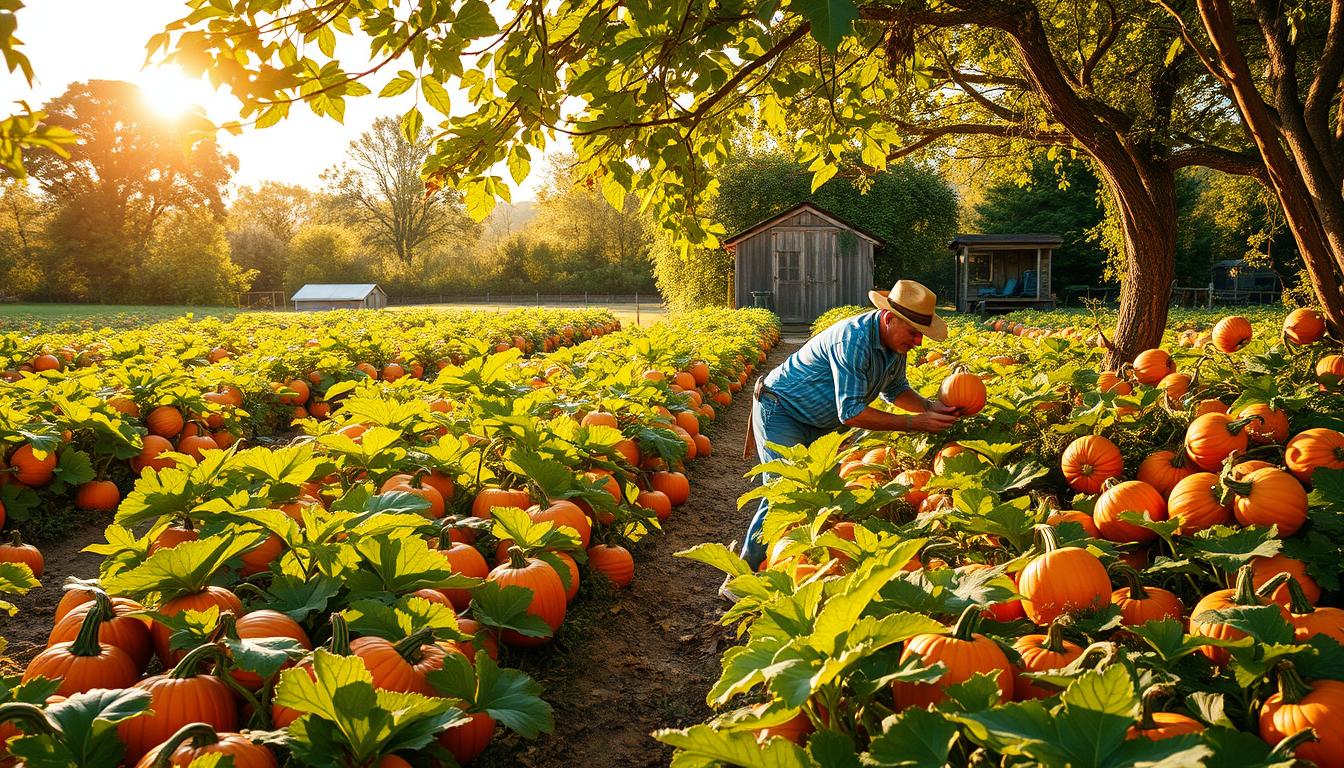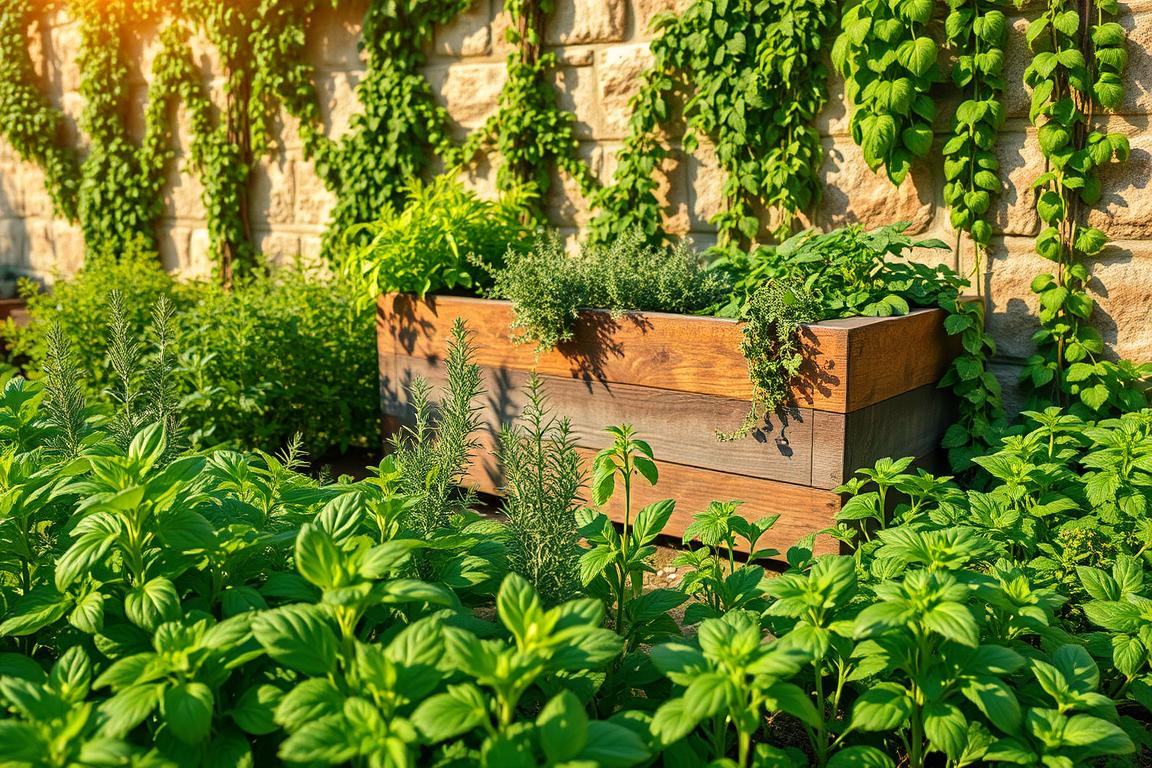Creating a hummingbird habitat turns ordinary gardens into vibrant wildlife sanctuaries. Hummingbird gardening is more than just landscaping. It’s about designing spaces that attract and support these amazing tiny birds. Gardeners in the United States can use techniques to make their outdoor spaces welcoming to hummingbirds.
To attract hummingbirds, you need to plan carefully and understand their needs. These small birds look for places with nectar, safe spots to perch, and protection from predators. By using specific garden design tips, homeowners can make their gardens a haven for hummingbirds and boost biodiversity.
Creating a hummingbird habitat involves mixing natural elements with the right plants and landscape features. No matter if you have a small balcony or a big property, you can turn your garden into a hummingbird sanctuary. The key is to use the right approach.
Key Takeaways
- Understand hummingbird habitat preferences
- Select nectar-rich native plant species
- Create diverse garden environments
- Provide safe water and perching areas
- Support local hummingbird conservation efforts
Understanding Hummingbird Behavior and Essential Habitat Requirements
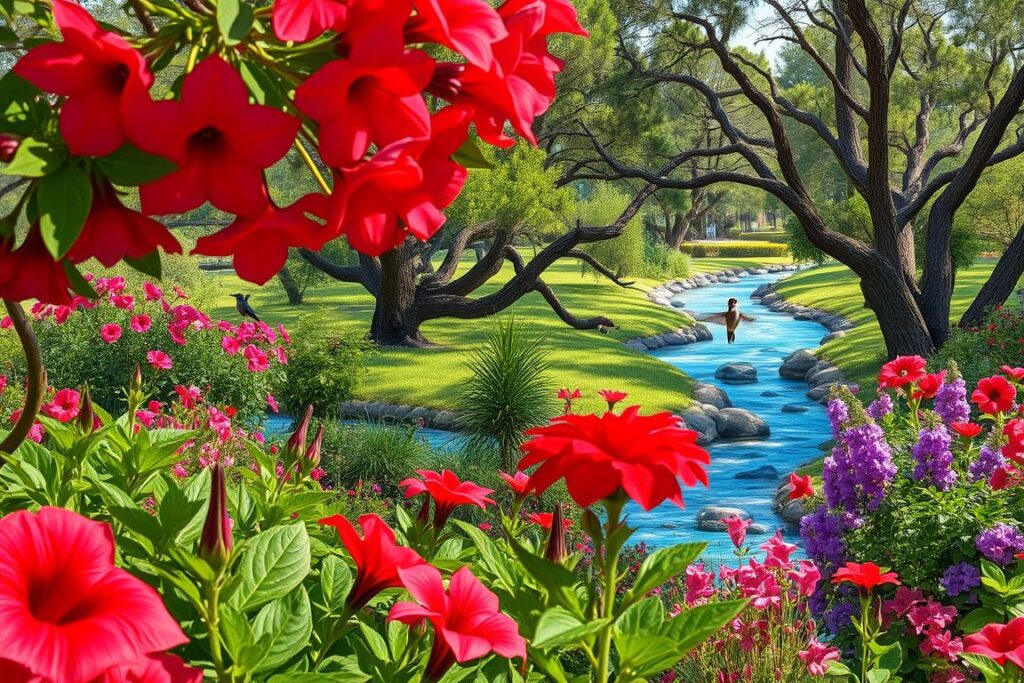
Hummingbirds are amazing creatures with special behaviors and habitat needs. They live in environments that match their high-energy lifestyle and survival strategies.
Exploring the world of hummingbirds shows us how they survive and interact with their environment. Their ability to adapt and their specific needs make them fascinating.
Natural Habitat Preferences
Hummingbirds love different ecosystems for their needs. They prefer places with lots of flowers and safe spots for nesting. Their favorite spots include:
- Woodland edges
- Tropical forest clearings
- Mountain meadows
- Gardens with diverse plant life
Feeding Patterns and Daily Needs
These birds need a lot of energy. They eat nectar from feeders and flowers every 10 to 15 minutes. They visit between 1,000 and 2,000 flowers each day. Their feeding habits are:
- Rapid energy consumption
- Constant foraging
- Strategic nectar source selection
Migration and Territory Habits
Hummingbirds migrate with incredible skill. Many return to the same places every year. They show great spatial memory and territorial behavior.
| Migration Characteristic | Details |
|---|---|
| Average Migration Distance | 500-2,000 miles |
| Migration Speed | 25-30 miles per hour |
| Annual Return Accuracy | Up to 90% precise location return |
Knowing these behaviors helps us create the best habitats for hummingbirds. This supports their unique needs.
How to Create a Hummingbird Habitat: Garden Design Tips That Work
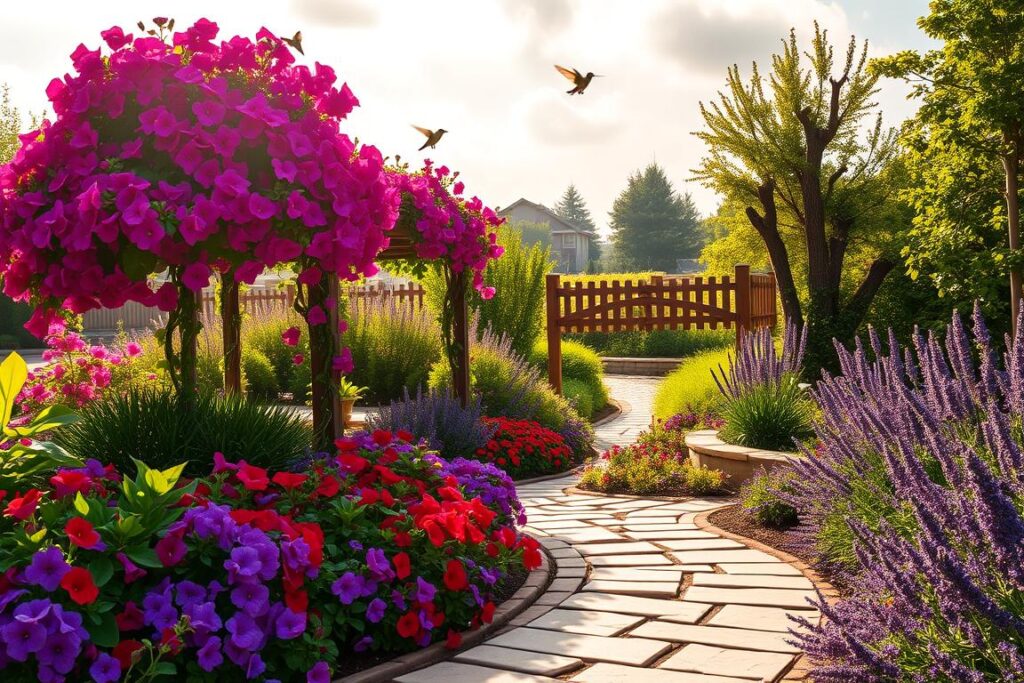
To make a hummingbird garden, you need to plan well and landscape smartly. A good plan can turn your backyard into a lively spot for these birds.
First, learn what hummingbirds need. Use green gardening ideas to make a home for them. This will also make your yard better.
Selecting the Perfect Location
Choosing the right spot for your hummingbird garden is key. Look for:
- Partial sunlight with some shade protection
- Proximity to existing trees or shrubs
- Clear viewing access from your home
- Protection from strong winds
“The right location can make all the difference in attracting and supporting hummingbirds.” – Wildlife Conservation Expert
Planning Your Garden Layout
Your garden should have a mix of plants and design elements. Group plants together to attract birds and look good.
- Group similar plants together
- Create layers of vegetation
- Ensure continuous blooming throughout seasons
- Maintain diverse plant heights
Incorporating Vertical Elements
Vertical features are key in a hummingbird garden. Use trellises, hanging baskets, and tall plants for perches and food.
Pro tip: Install thin branches or wire supports near nectar-producing plants to give hummingbirds convenient resting spots between feedings.
Essential Native Plants and Flowers for Hummingbirds
To attract hummingbirds, start with native plants. These birds have a special bond with local flowers. This bond is vital for their survival and the garden’s health.
Choosing native plants has many benefits. They offer nectar, support local life, and need less care than non-native plants.
- Red tubular flowers are a hit with hummingbirds
- Native flowering shrubs are perfect for feeding and nesting
- Perennial nectar plants provide food all year
Top Native Nectar Plants by Region
| Region | Recommended Native Plants | Bloom Season |
|---|---|---|
| Northeast | Cardinal Flower, Bee Balm | Summer-Fall |
| Southwest | Trumpet Honeysuckle, Sage | Spring-Summer |
| Pacific Northwest | Columbine, Red-Flowering Currant | Spring-Early Summer |
Design your garden with native plants in mind. Choose ones that fit your local climate and bloom all season. Diversity is key for a thriving habitat for these amazing pollinators.
Water Features and Perching Areas for Hummingbirds
Creating a backyard wildlife habitat for hummingbirds is more than just nectar feeders. These birds need specific water sources and places to rest. This makes your garden a safe and welcoming space for them.
Hummingbirds have special needs for water and shelter. Knowing how to set up the right water features and perching spots can turn your garden into a perfect haven for them.
Creating Safe Water Sources
Water is key for hummingbirds, but they like certain types:
- Shallow misters that create fine water droplets
- Small drip fountains with gentle water movement
- Leaf-mounted water collectors
- Lightweight water basins with rough surfaces
Strategic Perch Placement
Designing shelter for hummingbirds means creating the perfect resting spots. They need safe places to:
- Rest between feeding sessions
- Observe their territory
- Protect themselves from predators
Natural Shelter Options
Hummingbird houses and natural plants are crucial for protection. Consider adding:
- Dense shrubs with thin branches
- Small trees with multiple perching points
- Native plants with broad leaves
- Vertical garden structures
“A well-designed habitat is more than food—it’s about creating a complete ecosystem for hummingbirds.”
By adding water sources and strategic perching areas, you’ll make your backyard a welcoming place. It will attract and support these amazing birds all year round.
Maintaining a Healthy Hummingbird Environment
To create a thriving backyard for wildlife, focus on sustainable gardening. It’s key to avoid using pesticides. This protects hummingbirds and their ecosystem. These birds are very sensitive to toxins in their food.
Keeping hummingbird feeders clean is important. You need to clean and manage nectar well to stop bacteria. Here are some tips:
- Clean feeders every 2-3 days in warm weather
- Use a mild soap solution for thorough washing
- Rinse completely with hot water
- Replace nectar before it becomes cloudy or fermented
Using natural pest control helps your garden without harming hummingbirds. Try these green options:
- Introduce beneficial insects
- Plant companion crops that naturally repel harmful pests
- Use neem oil or vinegar-based solutions for targeted treatments
Preparing your garden for each season is crucial. Protecting from extreme temperatures and keeping native plants diverse helps hummingbirds all year.
A healthy hummingbird environment is a balanced ecosystem that prioritizes natural processes and minimal human intervention.
Conclusion
Creating a hummingbird-friendly garden is more than a hobby. It’s a way to connect with nature in your own backyard. By following the tips in this guide, even tiny spaces can become homes for these amazing birds.
Using eco-friendly gardening helps local wildlife. Watching birds in your garden becomes more exciting when it’s designed for them. Choosing native plants and adding water and perches makes your garden a welcoming place.
Your work does more than just entertain you. It helps local wildlife and supports these important pollinators. Begin with small steps, be patient, and see your garden become a lively haven for hummingbirds.
Start your journey to create a hummingbird-friendly garden. With commitment and the right steps, you’ll make your outdoor area better and help wildlife conservation. You can make a difference, one garden at a time.
FAQ
What attracts hummingbirds to a garden?
Hummingbirds love nectar-rich flowers, feeders, water, and safe spots. They’re drawn to red flowers, clean feeders, and shallow water. A garden without pesticides offers shelter and food all day.
How often should I clean my hummingbird feeder?
Clean feeders every 3-5 days in warm weather. In cooler times, clean them every 7 days. Use soap, rinse well, and make sure no soap is left. Change the nectar often to stop mold and bacteria.
What is the best nectar recipe for hummingbird feeders?
Mix 4 parts water with 1 part white sugar. Boil the water, dissolve the sugar, and cool it before filling. Don’t use honey, artificial sweeteners, or red dye, as they’re bad for hummingbirds.
Which native plants are best for attracting hummingbirds?
Great plants include bee balm, cardinal flower, and columbine. Also, trumpet honeysuckle and native salvias are good. They offer natural food and fit well in local areas, helping hummingbirds and other wildlife.
How can I create a hummingbird habitat in a small space?
Small areas can still attract hummingbirds. Use vertical gardens, hang feeders, and plant compact native flowers. Add layered plants for places to feed and rest.
When is the best time to set up a hummingbird garden?
Start your garden early spring, before hummingbirds migrate. This way, it’s ready when they return, offering food and shelter right away.
Do hummingbirds need water sources beside nectar?
Yes, they need water for drinking and bathing. Use shallow misters, drip fountains, and small water features. These help keep their feathers clean and hydrated.
How can I protect hummingbirds from predators?
Make a safe space with dense shrubs and feeders near cover. Avoid open areas and place feeders at different heights. This keeps predators away from feeders.
Are sugar water feeders a good supplement to natural nectar sources?
Feeders are great during migration or when flowers are scarce. But, they should not replace a garden with native plants. This provides more nutrients and supports the ecosystem.
How can I make my hummingbird habitat environmentally sustainable?
Use native plants, avoid pesticides, and offer diverse nectar sources. Include water features and natural shelter. A sustainable garden supports hummingbirds and other wildlife.


